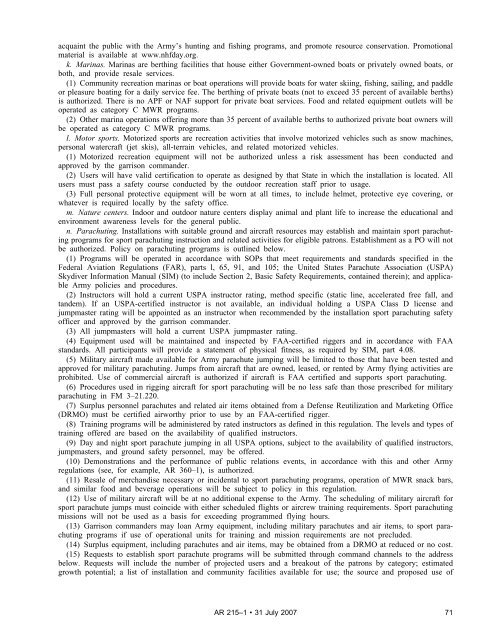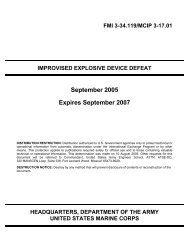AR 215-1 - Soldier Support Institute - U.S. Army
AR 215-1 - Soldier Support Institute - U.S. Army
AR 215-1 - Soldier Support Institute - U.S. Army
You also want an ePaper? Increase the reach of your titles
YUMPU automatically turns print PDFs into web optimized ePapers that Google loves.
acquaint the public with the <strong>Army</strong>’s hunting and fishing programs, and promote resource conservation. Promotional<br />
material is available at www.nhfday.org.<br />
k. Marinas. Marinas are berthing facilities that house either Government-owned boats or privately owned boats, or<br />
both, and provide resale services.<br />
(1) Community recreation marinas or boat operations will provide boats for water skiing, fishing, sailing, and paddle<br />
or pleasure boating for a daily service fee. The berthing of private boats (not to exceed 35 percent of available berths)<br />
is authorized. There is no APF or NAF support for private boat services. Food and related equipment outlets will be<br />
operated as category C MWR programs.<br />
(2) Other marina operations offering more than 35 percent of available berths to authorized private boat owners will<br />
be operated as category C MWR programs.<br />
l. Motor sports. Motorized sports are recreation activities that involve motorized vehicles such as snow machines,<br />
personal watercraft (jet skis), all-terrain vehicles, and related motorized vehicles.<br />
(1) Motorized recreation equipment will not be authorized unless a risk assessment has been conducted and<br />
approved by the garrison commander.<br />
(2) Users will have valid certification to operate as designed by that State in which the installation is located. All<br />
users must pass a safety course conducted by the outdoor recreation staff prior to usage.<br />
(3) Full personal protective equipment will be worn at all times, to include helmet, protective eye covering, or<br />
whatever is required locally by the safety office.<br />
m. Nature centers. Indoor and outdoor nature centers display animal and plant life to increase the educational and<br />
environment awareness levels for the general public.<br />
n. Parachuting. Installations with suitable ground and aircraft resources may establish and maintain sport parachuting<br />
programs for sport parachuting instruction and related activities for eligible patrons. Establishment as a PO will not<br />
be authorized. Policy on parachuting programs is outlined below.<br />
(1) Programs will be operated in accordance with SOPs that meet requirements and standards specified in the<br />
Federal Aviation Regulations (F<strong>AR</strong>), parts l, 65, 91, and 105; the United States Parachute Association (USPA)<br />
Skydiver Information Manual (SIM) (to include Section 2, Basic Safety Requirements, contained therein); and applicable<br />
<strong>Army</strong> policies and procedures.<br />
(2) Instructors will hold a current USPA instructor rating, method specific (static line, accelerated free fall, and<br />
tandem). If an USPA-certified instructor is not available, an individual holding a USPA Class D license and<br />
jumpmaster rating will be appointed as an instructor when recommended by the installation sport parachuting safety<br />
officer and approved by the garrison commander.<br />
(3) All jumpmasters will hold a current USPA jumpmaster rating.<br />
(4) Equipment used will be maintained and inspected by FAA-certified riggers and in accordance with FAA<br />
standards. All participants will provide a statement of physical fitness, as required by SIM, part 4.08.<br />
(5) Military aircraft made available for <strong>Army</strong> parachute jumping will be limited to those that have been tested and<br />
approved for military parachuting. Jumps from aircraft that are owned, leased, or rented by <strong>Army</strong> flying activities are<br />
prohibited. Use of commercial aircraft is authorized if aircraft is FAA certified and supports sport parachuting.<br />
(6) Procedures used in rigging aircraft for sport parachuting will be no less safe than those prescribed for military<br />
parachuting in FM 3–21.220.<br />
(7) Surplus personnel parachutes and related air items obtained from a Defense Reutilization and Marketing Office<br />
(DRMO) must be certified airworthy prior to use by an FAA-certified rigger.<br />
(8) Training programs will be administered by rated instructors as defined in this regulation. The levels and types of<br />
training offered are based on the availability of qualified instructors.<br />
(9) Day and night sport parachute jumping in all USPA options, subject to the availability of qualified instructors,<br />
jumpmasters, and ground safety personnel, may be offered.<br />
(10) Demonstrations and the performance of public relations events, in accordance with this and other <strong>Army</strong><br />
regulations (see, for example, <strong>AR</strong> 360–1), is authorized.<br />
(11) Resale of merchandise necessary or incidental to sport parachuting programs, operation of MWR snack bars,<br />
and similar food and beverage operations will be subject to policy in this regulation.<br />
(12) Use of military aircraft will be at no additional expense to the <strong>Army</strong>. The scheduling of military aircraft for<br />
sport parachute jumps must coincide with either scheduled flights or aircrew training requirements. Sport parachuting<br />
missions will not be used as a basis for exceeding programmed flying hours.<br />
(13) Garrison commanders may loan <strong>Army</strong> equipment, including military parachutes and air items, to sport parachuting<br />
programs if use of operational units for training and mission requirements are not precluded.<br />
(14) Surplus equipment, including parachutes and air items, may be obtained from a DRMO at reduced or no cost.<br />
(15) Requests to establish sport parachute programs will be submitted through command channels to the address<br />
below. Requests will include the number of projected users and a breakout of the patrons by category; estimated<br />
growth potential; a list of installation and community facilities available for use; the source and proposed use of<br />
<strong>AR</strong> <strong>215</strong>–1 • 31 July 2007<br />
71

















